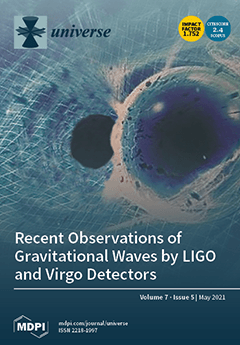Investigations that were carried out over the last two decades with novel and more sensitive instrumentation have dramatically improved our knowledge of the more violent physical processes taking place in galactic and extra-galactic Black-Holes, Neutron Stars, Supernova Remnants/Pulsar Wind Nebulae, and other regions
[...] Read more.
Investigations that were carried out over the last two decades with novel and more sensitive instrumentation have dramatically improved our knowledge of the more violent physical processes taking place in galactic and extra-galactic Black-Holes, Neutron Stars, Supernova Remnants/Pulsar Wind Nebulae, and other regions of the Universe where relativistic acceleration processes are in place. In particular, simultaneous and/or combined observations with
-ray satellites and ground based high-energy telescopes, have clarified the scenario of the mechanisms responsible for high energy photon emission by leptonic and hadronic accelerated particles in the presence of magnetic fields. Specifically, the European Space Agency INTEGRAL soft
-ray observatory has detected more than 1000 sources in the soft
-ray band, providing accurate positions, light curves and time resolved spectral data for them. Space observations with Fermi-LAT and observations that were carried out from the ground with H.E.S.S., MAGIC, VERITAS, and other telescopes sensitive in the GeV-TeV domain have, at the same time, provided evidence that a substantial fraction of the cosmic sources detected are emitting in the keV to TeV band via Synchrotron-Inverse Compton processes, in particular from stellar galactic BH systems as well as from distant black holes. In this work, employing a spatial cross correlation technique, we compare the INTEGRAL/IBIS and TeV all-sky data in search of secure or likely associations. Although this analysis is based on a subset of the INTEGRAL all-sky observations (1000 orbits), we find that there is a significant correlation: 39 objects (∼20% of the VHE
-ray catalogue) show emission in both soft
-ray and TeV wavebands. The full INTEGRAL database, now comprising almost 19 years of public data available, will represent an important legacy that will be useful for the Cherenkov Telescope Array (CTA) and other ground based large projects.
Full article





